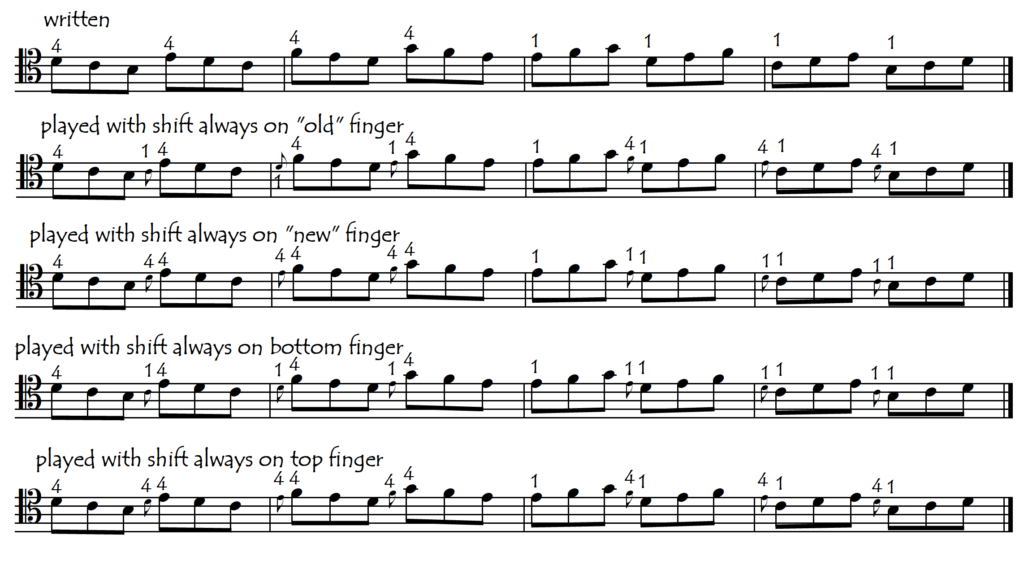Same-Finger Shifts
SHIFT DISTANCE AND MUSICAL INTERVAL
It is only in same-finger shifts that the shift distance corresponds exactly to the musical interval (see Shift Choreography).
SAME-FINGER SHIFTS AS THE ESSENTIAL FOUNDATION OF ALL SHIFTS
These are the most basic, fundamental and useful shifts. In fact, all shifts are ultimately basically “same finger shifts”. Assisted Shifts and Scale/Arpeggio-Type Shifts are just Same-Finger Shifts with the added complication that another finger is put down and/or taken off somewhere along the way, either before, during or after the shift.
Ascending scale shifts on one string provide a very good example of the absolutely fundamental importance of our same-finger shifting skills on the lower finger. Even though the finger choreography goes from a higher finger to a lower finger, the shifts are basically just same-finger shifts on the lower finger (most commonly the first finger). Therefore a prerequisite for good fluent secure scales on one string is the optimal functioning of these arpeggio-interval same-finger shifts on the first finger.

The same principle applies also in Assisted Shifts, which we can practice as Same-Finger shifts on either the lower or the higher finger:

Because same-finger shifts are the basic foundation of all shifting, we need to work on them a lot. Scales using only one finger are the most basic tool for learning and improving shifting technique, but arpeggio intervals are even better than stepwise intervals for building strength because they have to resist the greater drag (friction) that is created during the longer shifts. Here are some pages of exercises working on same-finger shifts on all the different fingers (including the thumb) across all the fingerboard regions. We will start with stepwise shifts and gradually build up to larger intervals.
Basic Same-Finger Shifting: Stepwise: All Fingers: All Regions: EXERCISES
First Finger Shifts: Stepwise: All Regions: EXERCISES
First Finger Shifts: Mixed Thirds: All Regions: EXERCISES
First Finger Shifts: Perfect Fourths: All Regions: No Extensions: EXERCISES
First Finger Shifts: Larger Intervals: All Regions: EXERCISES
Second Finger Shifts: Stepwise and Thirds: All Regions: EXERCISES
Top Finger Shifts: Stepwise and Thirds: All Regions: EXERCISES
SAME-FINGER SHIFTING IN DOUBLE-STOPS
We might think that doublestopped shifting exercises would be even better for developing strength because the hand has to work so hard. While this is true for the hand as a whole, it is however not true for each individual finger, because in doublestopped shifts the “load” is shared between the two stopping fingers. But shifting in doublestops is a very good way to train our ear to hear and correct two notes at once. Try the following exercises to test these two ideas for yourself:
Same-finger Doublestopped Chromatic Scales
Doublestopped Shifts On First Finger: Tonal Stepwise Doublestopped Shifts On Second Finger: Tonal Stepwise
Same Finger Doublestopped Minor Third Shifts
SHIFTING ON THE EXTENDED FIRST FINGER FOR DEVELOPING EXTRA STRENGTH?
We might also think that exercises involving shifting on the extended first finger would also be good for building strength, because once again, the hand has to work so hard. For a small hand however, shifting on the extended first finger is simply so unergonomic that it is like lifting weights in an unbalanced posture. Yes, this is definitely hard work, but not only does it not actually help to create core strength but it can in fact be ergonomically dangerous (possibility of over-strain and injury). This is why we have to be careful with these permanently-extended exercises. Try the following ones to test this idea for yourself:
First Finger Shifts: Perfect Fourths: All Regions: Always Extended: EXERCISES
